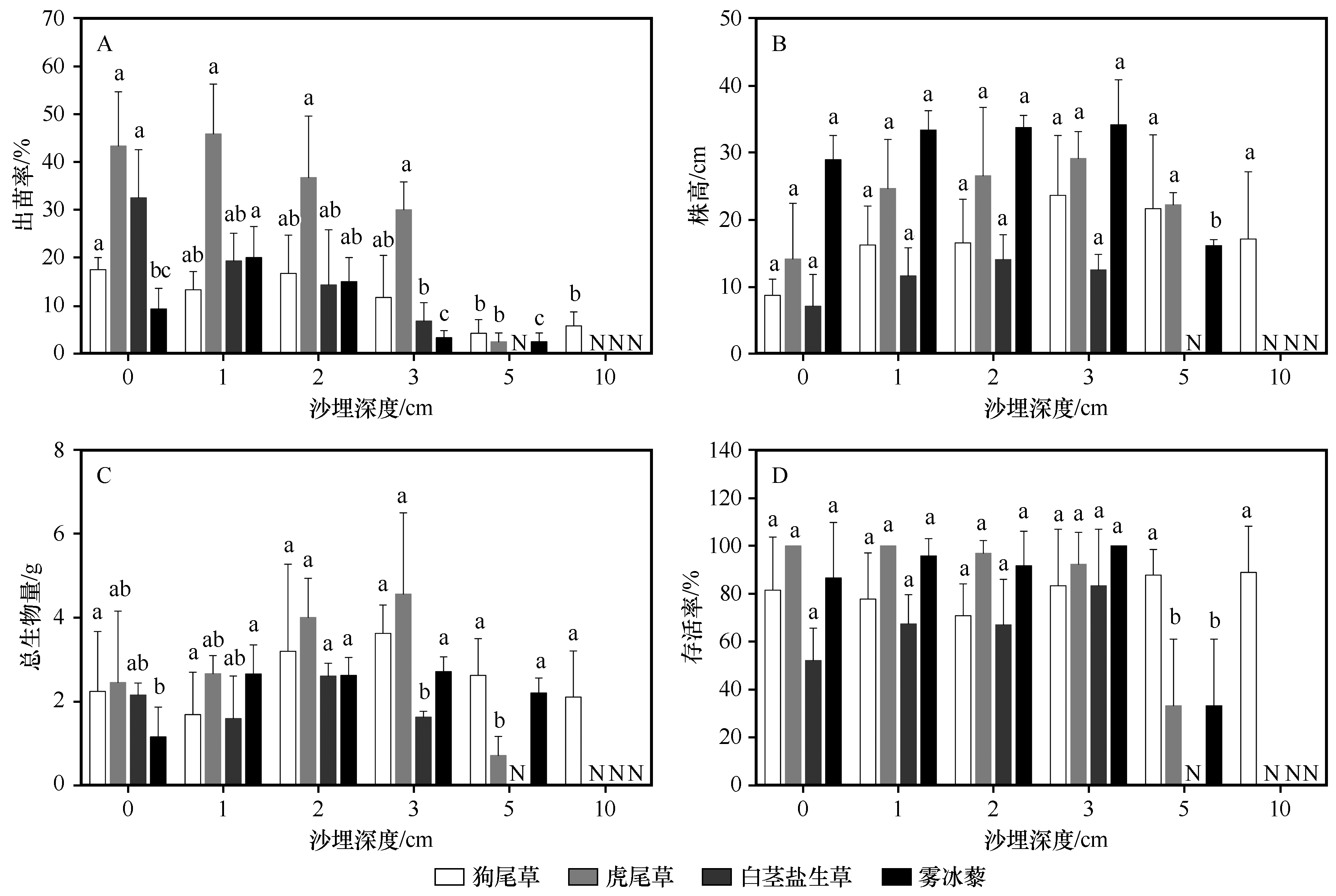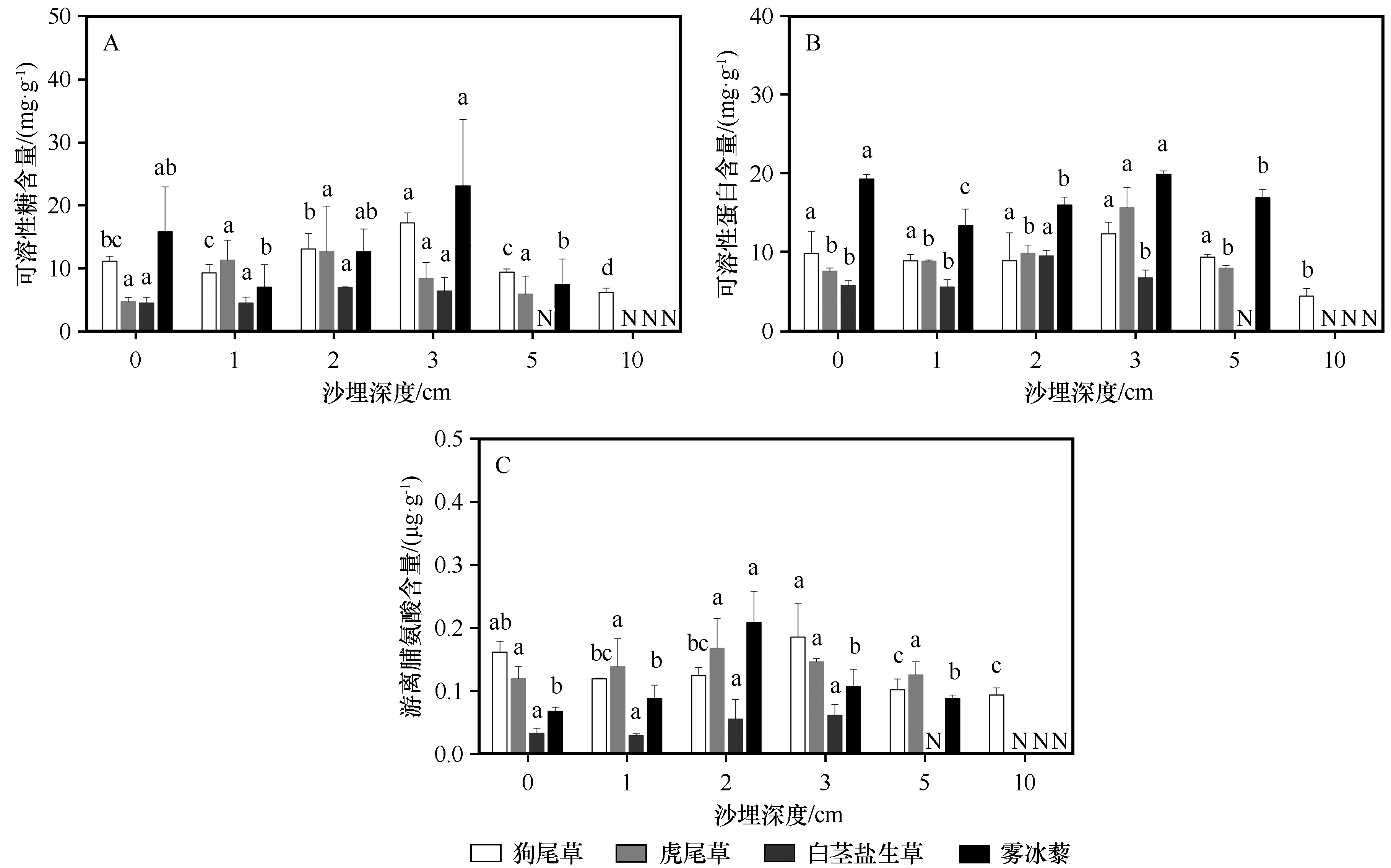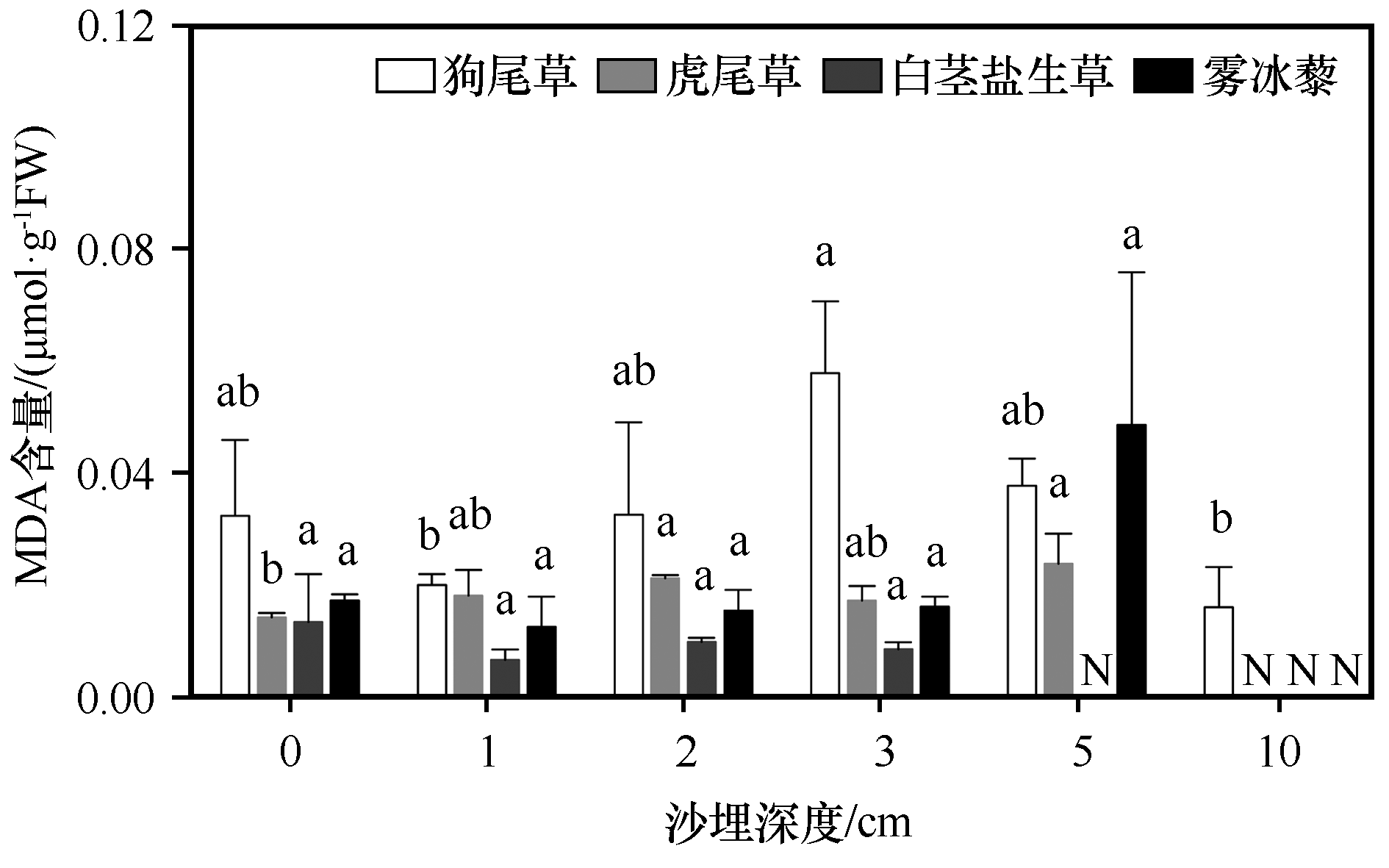
- CN 62-1070/P
- ISSN 1000-694X
- Bimonthly 1981

Journal of Desert Research ›› 2021, Vol. 41 ›› Issue (3): 185-194.DOI: 10.7522/j.issn.1000-694X.2021.00009
Bing Song1( ), Guohua Wang1,2(
), Guohua Wang1,2( ), Qianqian Gou1,2, Lulu Xi1
), Qianqian Gou1,2, Lulu Xi1
Received:2020-09-09
Revised:2021-01-29
Online:2021-05-26
Published:2021-05-26
Contact:
Guohua Wang
CLC Number:
Bing Song, Guohua Wang, Qianqian Gou, Lulu Xi. Effects of sand-buried on annual herbaceous plants in desert-oasis ecotone of Hexi Corridor Gansu, China[J]. Journal of Desert Research, 2021, 41(3): 185-194.
Add to citation manager EndNote|Ris|BibTeX
URL: http://www.desert.ac.cn/EN/10.7522/j.issn.1000-694X.2021.00009

Fig.2 The seedling emergence rate, plant height, total biomass and survival rate of four annual herbaceous plants (Setaria viridis, Chloris virgata, Halogeton arachnoideus, Bassia dasyphyll) under different sand-buried depths (Different letters indicate the same plant has significant differences in different sand burial depths. N represents no seedling)
| 科 | 种 | 沙埋深度/cm | 百粒重/mg | 每株结种量/粒 |
|---|---|---|---|---|
| 禾本科 (Gramineae) | 狗尾草 (Setaria viridis) | 0 | 20.0±5.4a | 38.7±10.4a |
| 1 | 26.9±5.3a | 75.8±23.1ab | ||
| 2 | 22.6±7.9a | 109.7±32.9b | ||
| 3 | 41.9±10.5b | 115.6±33.4b | ||
| 5 | 24.7±2.4a | 108.9±21.3b | ||
| 10 | 19.6±6.8a | 105.8±36.6b | ||
| 虎尾草 (Chloris virgate) | 0 | 12.0±3.1a | 170.8±44.4b | |
| 1 | 30.9±7.0bc | 214.2±48.7b | ||
| 2 | 27.2±9.3bc | 410.8±54.1c | ||
| 3 | 36.5±5.7c | 366.2±57.7c | ||
| 5 | 20.0±3.5ab | 32.0±5.5a | ||
| 藜科 (Chenopodiaceae) | 白茎盐生草 (Halogeton arachnoideus) | 0 | — | — |
| 1 | — | — | ||
| 2 | — | — | ||
| 3 | — | — | ||
| 雾冰藜 (Bassia dasyphylla) | 0 | 42.9±14.6ab | 11.7±4.7a | |
| 1 | 67.4±13.1b | 56.6±19.4b | ||
| 2 | 71.5±21.8b | 174.2±37.4c | ||
| 3 | 63.7±17.6ab | 69.8±20.2b | ||
| 5 | 35.2±6.1a | 66.0±11.4b |
Table 1 Propagation quality (the weight of 100 diaspore) and quantity (seed production) of four annual herbaceous plants under different sand burial depths
| 科 | 种 | 沙埋深度/cm | 百粒重/mg | 每株结种量/粒 |
|---|---|---|---|---|
| 禾本科 (Gramineae) | 狗尾草 (Setaria viridis) | 0 | 20.0±5.4a | 38.7±10.4a |
| 1 | 26.9±5.3a | 75.8±23.1ab | ||
| 2 | 22.6±7.9a | 109.7±32.9b | ||
| 3 | 41.9±10.5b | 115.6±33.4b | ||
| 5 | 24.7±2.4a | 108.9±21.3b | ||
| 10 | 19.6±6.8a | 105.8±36.6b | ||
| 虎尾草 (Chloris virgate) | 0 | 12.0±3.1a | 170.8±44.4b | |
| 1 | 30.9±7.0bc | 214.2±48.7b | ||
| 2 | 27.2±9.3bc | 410.8±54.1c | ||
| 3 | 36.5±5.7c | 366.2±57.7c | ||
| 5 | 20.0±3.5ab | 32.0±5.5a | ||
| 藜科 (Chenopodiaceae) | 白茎盐生草 (Halogeton arachnoideus) | 0 | — | — |
| 1 | — | — | ||
| 2 | — | — | ||
| 3 | — | — | ||
| 雾冰藜 (Bassia dasyphylla) | 0 | 42.9±14.6ab | 11.7±4.7a | |
| 1 | 67.4±13.1b | 56.6±19.4b | ||
| 2 | 71.5±21.8b | 174.2±37.4c | ||
| 3 | 63.7±17.6ab | 69.8±20.2b | ||
| 5 | 35.2±6.1a | 66.0±11.4b |

Fig.3 Changes of soluble sugar, soluble protein and free proline in the leaves of four annual herbaceous plants (Setaria viridis, Chloris virgata, Halogeton arachnoideus, Bassia dasyphyll) at different sand-burial depths(Different letters indicate the same plant has significant differences in different sand burial depths. N represents no seedling)

Fig.4 Changes of malondialdehyde (MDA) content in the leaves of four annual herbaceous plants (Setaria viridis, Chloris virgata, Halogeton arachnoideus, Bassia dasyphyll) at different sand-burying depths(Different letters indicate the same plant has significant differences in different sand burial depths. N represents no seedling)

Fig.5 Changes of chlorophyll content in leaves of four annual herbaceous plants (Setaria viridis, Chloris virgata, Halogeton arachnoideus, Bassia dasyphyll) at different sand-burying depths(Different letters indicate the same plant has significant differences in different sand burialdepths. N represents no seedling)
| 植物种 | 指标 | 渗透调节物质 | 丙二醛 | 叶绿素 | ||
|---|---|---|---|---|---|---|
| 可溶性糖 | 可溶性蛋白 | 游离脯氨酸 | ||||
| 狗尾草 | 株高 | 0.310 | -0.237 | 0.0449 | 0.455 | -0.220 |
| 总生物量 | 0.554* | -0.226 | 0.303 | 0.339 | 0.377 | |
| 存活率 | -0.393 | -0.391 | -0.491 | -0.526 | -0.653** | |
| 虎尾草 | 株高 | 0.377 | 0.443 | -0.041 | -0.067 | 0.175 |
| 总生物量 | 0.352 | 0.728** | -0.716** | -0.351 | 0.271 | |
| 存活率 | 0.283 | 0.245 | -0.897** | -0.405 | 0.745** | |
| 白茎盐生草 | 株高 | 0.297 | 0.336 | 0.605* | -0.614* | 0.399 |
| 总生物量 | -0.007 | 0.383 | -0.299 | 0.359 | 0.049 | |
| 存活率 | 0.375 | 0.177 | 0.725** | -0.189 | 0.156 | |
| 雾冰藜 | 株高 | 0.283 | -0.051 | 0.343 | -0.514* | 0.134 |
| 总生物量 | 0.154 | -0.225 | 0.270 | 0.111 | -0.048 | |
| 存活率 | 0.324 | 0.082 | 0.188 | -0.761** | 0.668** | |
Table 2 Correlation analysis of growth and physiological indexes of four annual herbs.
| 植物种 | 指标 | 渗透调节物质 | 丙二醛 | 叶绿素 | ||
|---|---|---|---|---|---|---|
| 可溶性糖 | 可溶性蛋白 | 游离脯氨酸 | ||||
| 狗尾草 | 株高 | 0.310 | -0.237 | 0.0449 | 0.455 | -0.220 |
| 总生物量 | 0.554* | -0.226 | 0.303 | 0.339 | 0.377 | |
| 存活率 | -0.393 | -0.391 | -0.491 | -0.526 | -0.653** | |
| 虎尾草 | 株高 | 0.377 | 0.443 | -0.041 | -0.067 | 0.175 |
| 总生物量 | 0.352 | 0.728** | -0.716** | -0.351 | 0.271 | |
| 存活率 | 0.283 | 0.245 | -0.897** | -0.405 | 0.745** | |
| 白茎盐生草 | 株高 | 0.297 | 0.336 | 0.605* | -0.614* | 0.399 |
| 总生物量 | -0.007 | 0.383 | -0.299 | 0.359 | 0.049 | |
| 存活率 | 0.375 | 0.177 | 0.725** | -0.189 | 0.156 | |
| 雾冰藜 | 株高 | 0.283 | -0.051 | 0.343 | -0.514* | 0.134 |
| 总生物量 | 0.154 | -0.225 | 0.270 | 0.111 | -0.048 | |
| 存活率 | 0.324 | 0.082 | 0.188 | -0.761** | 0.668** | |
| 1 | 王涛,宋翔,颜长珍,等.近35 a来中国北方土地沙漠化趋势的遥感分析[J].中国沙漠,2011,31(6):1351-1356. |
| 2 | 陈文,王桔红,朱慧,等.沙埋对河西走廊4种旱生植物种子萌发和幼苗生长的影响[J].中国沙漠,2015,35(6):1532-1537. |
| 3 | Maun M A.Adaptations of plants to burial in coastal sand dunes[J].Canadian Journal of Botany,1998,76:713-738. |
| 4 | 王国华,赵文智.埋藏深度对梭梭(Haloxylon ammodendron)种子萌发及幼苗生长的影响[J].中国沙漠,2015,35(2):338-344. |
| 5 | Muna M A,Lpaierre J.Effects of burial by sand on seed germination and seedling emergence of four dune species[J].Amencan Journal of Bot-auy,1986,73(3):450-155. |
| 6 | Assche J A,Anlerbegrhe K A.The role of temperature on dormancy cycle of seeds of Rumer obtusifolius L[J].Functional Ecology,1989,3:107-115. |
| 7 | Vleeshouwers I M.Modeling the effect of temperature,soil penetration resistance,burial depth and seed weight on preemergence growth of weeds[J].Annals of Botany,1997,79:553-563. |
| 8 | 杨磊,王彦荣,余进德.干旱荒漠区土壤种子库研究进展[J].草业学报,2010,19(2):227-234. |
| 9 | 张金峰,闫兴富,孙毅,等.柠条种子萌发对不同光照强度和沙埋深度的响应[J].生态学杂志,2018,37(11):3262-3269. |
| 10 | 马红媛,梁正伟,闫超,等.四种沙埋深度对羊草种子出苗幼苗生长的影响[J].生态学杂志,2007,26(12):2003-2007. |
| 11 | 王桔红,柴雁飞,张勇.沙埋对醉马草种子萌发和幼苗生长的影响[J].生态学杂志,2010,29(2):324-328. |
| 12 | 肖萌,丁国栋,汪晓峰,等.沙埋和水分对3种灌草植物种子萌发及出苗的影响[J].中国水土保持科学,2014,12(4): 106-111. |
| 13 | 赵哈林,曲浩,周瑞莲,等.沙埋对沙米幼苗生长及生理过程的影响[J].应用生态学报,2013,24(12):3367-3372. |
| 14 | 马洋,王雪芹,韩章勇,等.风蚀沙埋对疏叶骆驼刺(Alhagi sparsifolia)和花花柴(Karelinia caspica)幼苗的生理影响[J].中国沙漠,2015,35(5):1254-1261. |
| 15 | 周瑞莲,侯玉平,左进城,等.不同沙地共有种沙生植物对环境的生理适应机理[J].生态学报,2015,35(2):340-349. |
| 16 | 何志斌,赵文智.黑河流域荒漠绿洲过渡带两种优势植物种群空间格局特征[J].应用生态学报,2004,15(6):947-952. |
| 17 | 赵文智,杨荣,刘冰,等.中国绿洲化及其研究进展[J].中国沙漠,2016,36(1):1-5. |
| 18 | 常学礼,韩艳,孙小艳,等.干旱区绿洲扩展过程中的景观变化分析[J].中国沙漠,2012,32(3):857-862. |
| 19 | 梁存柱,刘钟玲,朱宗元,等.阿拉善荒漠区一年生植物层片物种多样性及其分布特征[J].应用生态学报,2003,14(6):897-903. |
| 20 | 王永秋.降水变化对中亚荒漠一年生植物生活史的影响[D].乌鲁木齐:新疆农业大学,2016. |
| 21 | 闫巧玲,刘志民,李雪华,等.埋藏对65种半干旱草地植物种子萌发特性的影响[J].应用生态学报,2007,18(4):777-782. |
| 22 | 李秋艳,赵文智.五种荒漠植物幼苗出土及生长对沙埋深度的响应[J].生态学报,2006,26(6):1802-1808. |
| 23 | 刘冰.荒漠区灌木对降水脉动响应研究[D].北京:中国科学院, 2009. |
| 24 | Pammenter N W,Berjak P.Recalcitrant seeds:short-term storage effects in Avicennia merina (Forsk.) Vierh.May be germination-associated[J].Annals of Botany,1984,54:843-846. |
| 25 | 张志良,瞿伟菁.植物生理学实验指导[M].北京:高等教育出版社,2009:51-106. |
| 26 | Evenari M,Gutterman Y.Observation on the secondary succession of three plant communities in the Negev desert,Isereal:I.Atermisietum herbae albae[M]//Jacques R.Erudes de Biologie Vegetale.Paris:CNRS Gif Syr Yvette,1976:57-86. |
| 27 | Carol C B,Jerry M B.Seeds:ecology, biogeography,and evolution of dormancy and germination[J].Plant Ecology,2014:42-93. |
| 28 | Baskin J M,Baskin C C.The annual dormancy cycle in buried weed seeds:A continuum[J].Bioscience,1985,35:492-498. |
| 29 | 刘志民.科尔沁沙地植物繁殖对策[M].北京:气象出版社,2010:113-121. |
| 30 | 薛海霞,李清河,徐军,等.沙埋对唐古特白刺幼苗生长和生物量分配的影响[J].草业科学,2016,3(10):2062-2070. |
| 31 | 王文娟,贺达汉,唐小琴,等.不同温度和沙埋深度对砂生槐种子萌发及幼苗生长的影响[J].中国沙漠,2011,31(6):1437-1442. |
| 32 | 温都日呼,王铁娟,张颖娟,等.沙埋与水分对科尔沁沙地主要固沙植物出苗的影响[J].生态学报,2015,35(9):2985-2992. |
| 33 | Freas K E,Kemp P R.Some relationships between environmental reliability and seed dormancy in desert annual plants[J].Journal of Ecology,1983,71:211-217. |
| 34 | Bullock J.Plants[M]//Sutherland W J.Ecological Census Techniques:A Handbook.Cambridge,UK:Cambridge University Press,1996:56-89. |
| 35 | Aarssen L W.Body size and fitness in plants:revisiting the selection consequences of competition.perspectives in plant ecology[J].Evolution and Systematics,2015,17(3):236-242. |
| 36 | Weiner J.The influence of competition on plant reproduction[M]//Doust J L,Doust L L.Plant Reproductive Ecology,Patterns and Strategies.Oxford UK:Oxford University Press.228-245. |
| 37 | 钟章成.植物种群的繁殖对策[J].生态学杂志,1995,14(1):37-42. |
| 38 | Susko D J,Lovett-Doust L.Variable patterns of seed maturation and abortion in Alliaria pertiolata (Brassicaceae)[J].Canadian Journal of Botany,1998,76:1677-1686. |
| 39 | 路之娟,张永清,张楚.水分胁迫对不同基因型苦荞苗期根系生理特性及产量的影响[J].干旱地区农业研究,2018,36(2):124-136. |
| 40 | 郄亚栋.水盐影响下的梭梭生理响应机制及其生态适应[D].乌鲁木齐:新疆大学,2018. |
| 41 | 李合生.现代植物生理学[M].北京:高等教育出版社,2002:413-437. |
| 42 | 赵哈林,曲浩,周瑞莲,等.沙埋对沙米幼苗生长、存活及光合蒸腾特性的影响[J].生态学报,2013,33(18):5574-5579. |
| 43 | 赵哈林,赵学勇,张铜会.沙漠化的生物过程及退化植被的恢复机理[M].北京:科学出版社,2004:104-156. |
| 44 | 赵哈林,曲浩,周瑞莲,等.沙埋对两种沙生植物幼苗生长的影响及其生理响应差异[J].植物生态学报,2013,37(9):830-838. |
| 45 | 周瑞莲,赵彦宏,杨润亚,等.海滨滨麦叶片和根对不同厚度沙埋的生理响应差异分析[J].生态学报,2015,35(21):7080-7088. |
| [1] | Luo Dandan, Bai Xiaoming, Sun Yanmin, Jin Yanli, Chen Hui, Yuan Yajuan, Li Yujie. Response of Physiological Characteristics and Evaluation of Drought Tolerance for 10 Wild Iris lacteal var. chinensis from Gansu, China [J]. Journal of Desert Research, 2019, 39(5): 210-221. |
| [2] | Xu Jun, Chen Hailing, Hao Yuguang, Dong Lilong, Duan Na, Li Shuai, Ma Yingbin, Duan Ruibing, Liu Yuting. Gas Exchange and Drought-resistant Physiological Characteristics of Nitraria billardier Provenances in Ulan Buh Desert [J]. JOURNAL OF DESERT RESEARCH, 2017, 37(5): 917-924. |
| [3] | Tao Ling, Cao Tian, Lv Ying, Zhang Wenjie, Ren Jun. Function of Biological and Sand-fixation Polymer Material Based on Attapulgite [J]. JOURNAL OF DESERT RESEARCH, 2017, 37(2): 276-280. |
| [4] | Ma Yang, Wang Xueqin, Han Zhangyong, Liu Jinhui. Effect of Wind Erosion and Sand Burial on Physiological Characters in Alhagi sparsifolia and Karelinia caspica Seedlings in the Southern Margin of the Taklimakan Desert [J]. JOURNAL OF DESERT RESEARCH, 2015, 35(5): 1254-1261. |
| [5] | Mao Juan, Bai Jiangping, Zhang Junlian, Fan Aqi, Ma Zonghuan, Wu Jinhong, Wang Di. SnRK2 Gene Expression in Responses to Physiological Characteristics under Water Stress in Solanum tuberosum [J]. JOURNAL OF DESERT RESEARCH, 2014, 34(2): 481-487. |
| [6] | Gao Qian, Li Yi, Su Shiping, Анатолий Васильевич Жигунов, Shan Lishan, Chong Peifang. Effects of Salt Stress on Physiological Characteristics of Reaumuria soongorica Seeds during Imbibition [J]. JOURNAL OF DESERT RESEARCH, 2014, 34(1): 83-87. |
| [7] | ZHOU Zhi-bin1,2, ZHANG Yuan-ming1, Liliya Dimeyeva3. Comparison on Physiological Characteristics between the Original and Invasive Bromus tectorum Seedings [J]. JOURNAL OF DESERT RESEARCH, 2013, 33(3): 751-757. |
| [8] | QIU Zhen-jing;LI Yi;CHONG Pei-fang;SU Shi-ping. Comprehensive Evaluation on Drought Resistance of Calligonum mongolicum Turcz. from Different Geographical Provenance Based on Its Response to PEG Osmotic Stress [J]. JOURNAL OF DESERT RESEARCH, 2011, 31(5): 1231-1237. |
| [9] | ZHOU Hai-Yan, LI Xin-Rong, FAN Heng-Wen, WANG Xin-Ping, TAN Hui-Juan, LI Ai-Xia. Physiological Characteristics of Several Caragana Shrub Species under Extreme Conditions [J]. JOURNAL OF DESERT RESEARCH, 2005, 25(2): 182-190. |
| Viewed | ||||||
|
Full text |
|
|||||
|
Abstract |
|
|||||
©2018Journal of Desert Research
Tel:0931-8267545
Email:caiedit@lzb.ac.cn;desert@lzb.ac.cn
Support:Magtech